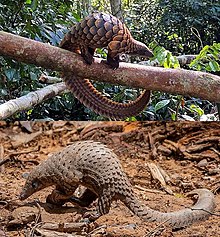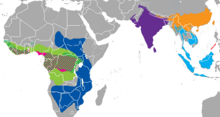Phataginus
| African tree pangolin | |
|---|---|

| |
| Pangolins from genus Phataginus | |
| Scientific classification | |
| Kingdom: | Animalia |
| Phylum: | Chordata |
| Class: | Mammalia |
| Order: | Pholidota |
| Family: | Manidae |
| Subfamily: | Phatagininae Gaubert, 2017 |
| Genus: | Phataginus Rafinesque, 1821 |
| Species | |

| |
| Synonyms[2][3] | |
|
synonyms of subfamily:
synonyms of genus:
| |
African tree pangolin (Phataginus) is a genus of African pangolins from subfamily small African pangolins (Phatagininae), within family Manidae.[5] Its members are the more arboreal of the African pangolins.[6]
The number of illegally trafficked pangolins from genus Phataginus were at least a shocking 895,000 from the years 2010 to 2019. The animal is hunted and poached for its scales and meat and is often used for the making of traditional medicine in places such as China and Vietnam. Attempts are still being made to help protect these mammals from trafficking and extinction, unfortunately their slow reproduction rate isn't much of assistance to this effort. Currently the tree pangolin is listed as vulnerable. All of the pangolins species have been listed as vulnerable, endangered and critically endangered.[7]
Etymology[]
Constantine Rafinesque (1821) formed the Neo-Latin generic name Phataginus from the French term phatagin, adopted by Count Buffon (1763) after the reported local name phatagin or phatagen used in the East Indies.
Taxonomy[]
- Subfamily: Phatagininae (small African pangolins)
- Genus: Phataginus (African tree pangolin)
- Phataginus tetradactyla (Long-tailed pangolin)
- Phataginus tricuspis (Tree pangolin)
- Genus: Phataginus (African tree pangolin)
Phylogeny[]
Phylogenetic position of genus Phataginus within family Manidae.[8][9][1]
| Pholidotamorpha |
| |||||||||||||||||||||||||||||||||||||||||||||||||||||||||||||||
(Pholidota sensu lato)
|
References[]
- ^ a b Philippe Gaubert, Agostinho Antunes, Hao Meng, Lin Miao, Stéphane Peigné, Fabienne Justy, Flobert Njiokou, Sylvain Dufour, Emmanuel Danquah, Jayanthi Alahakoon, Erik Verheyen, William T Stanley, Stephen J O’Brien, Warren E Johnson, Shu-Jin Luo (2018) The Complete Phylogeny of Pangolins: Scaling Up Resources for the Molecular Tracing of the Most Trafficked Mammals on Earth
- ^ "Manidae".
- ^ https://www.pangolinsg.org/wp-content/uploads/sites/4/2016/06/Heath-1992-Manis-Pentadactyla.pdf
- ^ "Taxonomic Swap 25736". iNaturalist. 2017-10-08. Retrieved 2019-09-17.
- ^ Schlitter, D.A. (2005). "Order Pholidota". In Wilson, D.E.; Reeder, D.M (eds.). Mammal Species of the World: A Taxonomic and Geographic Reference (3rd ed.). Johns Hopkins University Press. p. 531. ISBN 978-0-8018-8221-0. OCLC 62265494.
- ^ du Toit, Z.; du Plessis, M.; Dalton, D. L.; Jansen, R.; Paul Grobler, J.; Kotzé, A. (2017). "Mitochondrial genomes of African pangolins and insights into evolutionary patterns and phylogeny of the family Manidae". BMC Genomics. 18 (1): 746. doi:10.1186/s12864-017-4140-5. PMC 5609056. PMID 28934931.
- ^ Gaubert, P. (2020). "Development and characterization of 20 polymorphic microsatellite markers for the white-bellied pangolin Phataginus tricuspis (Mammalia, Pholidota). Molecular Biology Reports., 47(6), 4827–4833. https://doi.org/10.1007/s11033-020-05511-6
- ^ Gaudin, Timothy (2009). "The Phylogeny of Living and Extinct Pangolins (Mammalia, Pholidota) and Associated Taxa: A Morphology Based Analysis" (PDF). Journal of Mammalian Evolution. Heidelberg, Germany: Springer Science+Business Media. 16 (4): 235–305. doi:10.1007/s10914-009-9119-9. S2CID 1773698.
- ^ Kondrashov, Peter; Agadjanian, Alexandre K. (2012). "A nearly complete skeleton of Ernanodon (Mammalia, Palaeanodonta) from Mongolia: morphofunctional analysis". Journal of Vertebrate Paleontology. 32 (5): 983–1001. doi:10.1080/02724634.2012.694319. ISSN 0272-4634. S2CID 86059673.
- Phataginus
- Mammal genera
- Mammals of Sub-Saharan Africa
- Mammals of West Africa
- Mammals of Central Africa
- Taxa named by Constantine Samuel Rafinesque
- Mammal stubs




